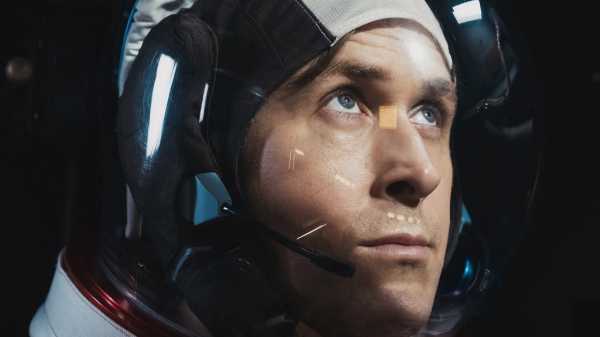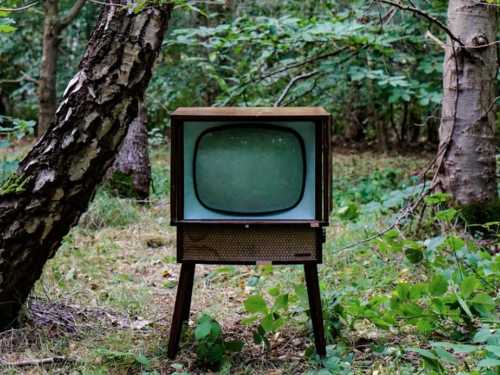
When “First Man,” Damien Chazelle’s drama about Neil Armstrong’s mission to the moon, premièred at the Venice Film Festival, in August, it stirred up an absurd controversy among right-wing blowhards who hadn’t seen the film but nonetheless damned it on the basis of reviews stating that the movie doesn’t depict the iconic moment when Armstrong planted the American flag on the lunar surface. It’s true that the flag-planting isn’t dramatized, but the blowhards need not worry: “First Man” is worthy of enduring as a right-wing fetish object. It is a film of deluded, cultish longing for an earlier era of American life, one defined not by conservative politics but, rather, by a narrow and regressive emotional perspective that shapes and distorts the substance of the film.
The general notion of “First Man” is to offer a corrective to the myth of the passive astronaut, the idea that American space explorers were merely strapped in, sent up, photo-opped, and brought home. Chazelle emphasizes, from start to finish, the physical punishment of space flight and Armstrong’s extraordinary, seemingly unique capacity to endure it. The movie begins with Neil (we’ll call the character by his first name, to distinguish him from the historical Armstrong) flying under intensely stressful conditions: his breathing is labored, his craft violently shakes, and, suddenly, instead of landing as planned, he’s rising—“bouncing off the atmosphere,” a flight controller tells him. Neil is serving as a civilian test pilot for NASA, and he’s flying a plane at an unprecedentedly high altitude; when he finally regains control of it, he narrowly misses crashing.
That first episode of mortal peril is only one of many that Neil confronts in the course of the film. Through his own courage, coolness of character, and physical sureness, he pulls through. But his coolness in flight is matched by a certain coolness on Earth, and the movie’s key dramatic contrast presents Neil as somewhat challenged in the realm of relationships. He’s married; he and his wife, Janet (Claire Foy), have three children. When his young daughter, Karen, dies of cancer, at the age of two, he’s heartbroken but has trouble showing it. He cries only in private; he never speaks of his grief. He turns a cold shoulder to Janet when she’s in need of attention, not from any lack of love but from an aversion to expression.
Neil’s seemingly selfish emotional remove is presented in the film as emblematic of and inseparable from his own stoic approach to danger, his own cool self-mastery in harrowing situations that would flummox and frazzle more expressive and less controlled people. Chazelle admires, above all, Neil’s capacity for suffering, which puts the character in line with other Chazelle protagonists—the bleeding drummer in “Whiplash,” the struggling jazzman and the anguished actress in “La La Land.” His heroes and heroine suffer so that others may delight. Throughout “First Man,” Chazelle takes pains to show that, despite Neil’s unwillingness to display his grief to others, he deeply mourned his daughter—and that, despite his stoic bearing, his grief doesn’t interfere with his work. (It’s even seen to inspire him to push himself to new peaks of endurance at a crucial moment in his training.) Though Neil’s lack of expression suggests a character flaw, it is, in Chazelle’s view, a virtuous one.
Yet Janet is clearly in pain. She complains to a friend that her life with Neil isn’t what she’d hoped it would be, saying, “I married Neil because I wanted a normal life”—i.e., she didn’t get one. Though Neil and Janet have their moments of happiness, his absorption in his work, the demands of his work, and his distant demeanor suggest severe rifts in their marriage. It’s another of Chazelle’s enduring themes—the man whose passionate devotion to his work makes the woman who doesn’t share his passion unhappy and dooms the relationship. It’s the story of his first feature, the low-budget musical “Guy and Madeline on a Park Bench,” and of “Whiplash” and “La La Land.”
The work to which Neil is devoted, the mission to the moon, is unabashedly depicted as patriotic. There’s no flag-planting, but the planted flag is seen clearly, twice; the movie doesn’t stint on the distinctive Americanism of the action onscreen (including, in a scene of Armstrong ascending from the ground to the capsule of Apollo 11 in an elevator, a point-of-view shot that reveals, majestically, the words “United States” painted, vertically, on the side of the very tall rocket). Earlier, when another space mission is successfully completed, one astronaut bellows in Mission Control, “Call the Soviets—tell ’em to go fuck themselves.” After the successful Apollo 11 moon landing, a French woman is interviewed and says, “I always trust an American. I knew they wouldn’t fail.” There’s a culture war at the core of “First Man,” or, rather, several, and Chazelle doesn’t merely suggest that they exist historically; he takes sides in them, and he does so as much with what he silences as with what he depicts.
There is, for instance, the war of commercial kitsch against both high culture and youth culture. The Armstrong household is in the realm of kitsch: when Neil is home with Janet, thinking of the moon, he puts on a record of “moon music”—easy-listening music with strings, a piano, a theremin, and a choir. (It’s a real thing—it’s called “Lunar Rhapsody” and is part of a 1947 album by Les Baxter.) Neil is so attached to the music that he brings a cassette of it into space and plays it in the capsule during flight. Little in the film suggests that the world of pop has undergone a change or that culture and mores were changing with it. There is one brief scene of a party at which something like rock music is playing, but there’s no sense of what Neil’s perspective might be on the Twist, the Beatles, or anything else going on in the turbulent sixties.
Nothing in the film suggests that Neil is even aware of what’s going on in the world around him. Much of the action in the movie takes place in Jim Crow states where public facilities were segregated, but there’s no hint of this in the film; there’s no hint of where Neil stands on the pressing questions of the time. He has no black colleagues, no female colleagues; meanwhile, a female cosmonaut, Valentina Tereshkova, flew a space mission for the Soviet Union in 1963. What did he think? There’s a news report on the Armstrong family TV about the Vietnam War—but, significantly, it’s Janet who’s home while it’s on. Neil is in space at the time—as if Chazelle were suggesting that, while such people as Janet both hold down the domestic front and fret about politics, Neil is too busy to bother with any of it. (The same is true of one brief appearance of antiwar protesters, which occurs just as Neil is mourning the deaths of his own colleagues—as if contrasting those who risk death with those who wouldn’t.)
The one scene that embodies the sixties onscreen is, to my mind, among the most contemptible scenes in recent movies. It takes place midway through the action, when Congress begins to question the value of the space program. Neil is dispatched to represent NASA in a meeting at the White House, where senators fret about “taxpayer dollars,” and while there he is summoned to the phone and informed of the deaths of three astronauts in an Apollo test. The point is clear: that the astronauts are risking their lives while Congress is counting beans and playing politics.
But Chazelle takes that notion even further a few minutes later in the film, when, racked with unspeakable grief over the deaths of his colleagues, Neil drives off to be alone. “Half the country” may oppose the moon mission, but here Chazelle offers a peculiar, tendentious, and self-revealing cinematic interpretation of that phrase in the form of a montage. It shows Kurt Vonnegut, appearing in a black-and-white television clip, saying that the government would do better to spend the money on such things as making New York City “habitable.” There’s an archival clip of chanting protesters, featuring, prominently, a sign saying “¡Ayuda al Pueblo!” and footage, staged for the movie, of Leon Bridges performing Gil Scott-Heron’s 1970 song “Whitey on the Moon.”
With this sequence, Chazelle openly mocks people who thought that the moon money was spent foolishly—those pesky intellectuals, blacks, and Hispanics who go on TV or into the street demanding “gimme” while the likes of Neil and his exclusively white, male colleagues uncomplainingly put their lives on the line to accomplish historic things in the interest of “mankind.” In its explicit content, and by artful omission, “First Man” subscribes to the misbegotten political premise that America used to be greater—and that the liberating and equalizing activism of the sixties ignored, dismissed, and even undermined that greatness.
What’s more, except for the protesters, “First Man” is whiter than a Fred-and-Ginger ballroom set. There are no “Hidden Figures” here; Neil, an engineer, does his own fancy calculations, thank you very much. The vast team effort to make the moon landing possible is reduced to background extras. The movie is centered on astronauts, who interact briefly with a handful of administrators and scientists; there are wives and children; and, otherwise, there are minions who line the corridor and cheer as Neil and his colleagues pass by on the way to the capsule. The moon mission was as much a matter of media as it was of science. The iconic moments of the moon landing are great television, and it took significant thought and labor on the part of NASA to figure out how to capture them. (The flag-planting, for instance, was a subject of debate prior to the mission, and when it happened Mission Control discussed it in real time as a fabulous photo op.) But Chazelle isn’t interested in process, or in how the facts were transformed into legend. Instead, he filters the legend to render it even more monumentally, unequivocally, inhumanly heroic.
In his earlier films, too, Chazelle had a severe case of cinematic surrogate ancestor-worship. Whether aimed at Buddy Rich in “Whiplash” or at the classic-jazz pantheon (and an inspirational aunt) in “La La Land,” his reverence for past heroes is matched only by that of Steven Spielberg—who, notably, is an executive producer of “First Man.” Compare Chazelle’s direction to Clint Eastwood’s in “Sully,” which sees through the heroic protagonist’s public image and his sense of responsibility to his tragic consciousness. Gazing up at Neil, Chazelle doesn’t dare give him any consciousness at all. Instead, he has made a historical film in which the historical element is so grossly distorted as to detach the hero from humanity. The world in which Neil functions is lunar in its isolation. The few and narrow traits that he’s assigned make him a cardboard cutout, a living poster man of bygone American heroism. A work with right-wing ideas doesn’t have to be a bad film, but “First Man” comes off as propaganda by mistake, by artistic obliviousness rather than by artistic design.
Sourse: newyorker.com






